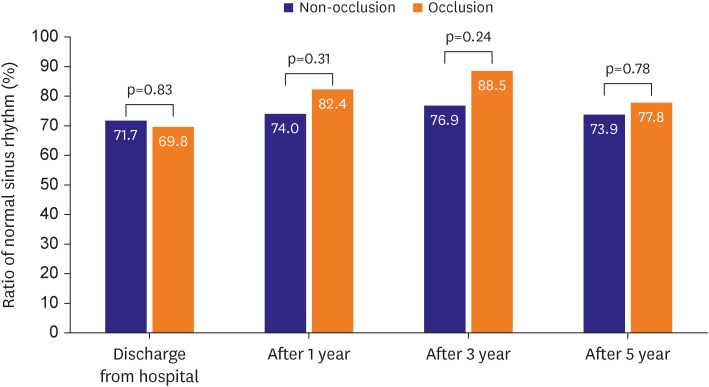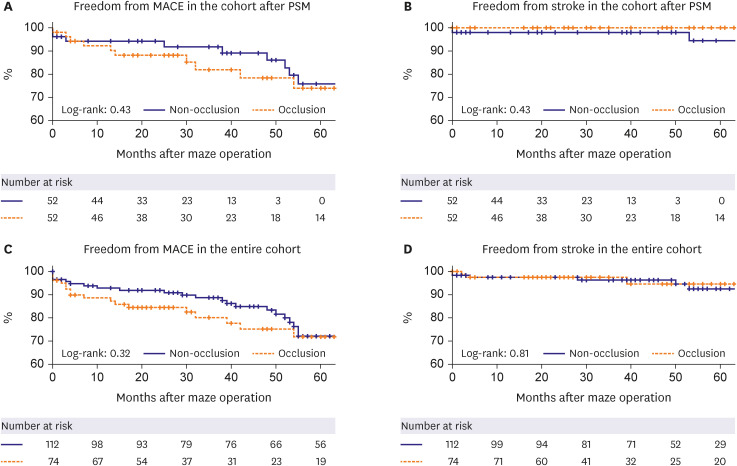Korean Circ J.
2023 Aug;53(8):566-577. 10.4070/kcj.2023.0038.
Is It Safe to Preserve Left Atrial Appendage During Maze Procedure?
- Affiliations
-
- 1Department of Thoracic and Cardiovascular Surgery, Keimyung University Dongsan Center, Keimyung University College of Medicine, Daegu, Korea
- KMID: 2545154
- DOI: http://doi.org/10.4070/kcj.2023.0038
Abstract
- Background and Objectives
The left atrial appendage (LAA) can contribute significantly to LA mechanical contraction. Nevertheless, the preventive effect of LAA occlusion during the maze procedure against cerebral infarction remains controversial. In this study, we compared the surgical, cardiac hemodynamic, and neurologic outcomes between LAA preservation and occlusion performed during the maze procedure.
Methods
Between January 2015 and August 2021, 252 patients underwent the maze procedure using cryoablation at our medical center. After excluding patients according to our exclusion criteria (i.e., mechanical prosthesis implantation, preexisting LAA thrombus), LAA was preserved in 113 patients (non-occlusion group) and occluded in 75 patients (occlusion group). Outcomes were compared using propensity score matching (PSM).
Results
PSM did not reveal significant intergroup differences in baseline characteristics between the non-occlusion (n=53) and occlusion (n=53) groups. During a median follow-up of 44 months, 2 patients in the non-occlusion group (3.8%) experienced ischemic strokes. There was no significant difference in the rate of freedom from stroke (p=0.19) and major adverse cardiac events (p=0.43) between the 2 groups. Through echocardiography at 1-year follow-up, a statistically significant difference in LA mechanical contraction was observed between the non-occlusion group and occlusion group (24 of 33 [72.7%] vs. 18 of 37 [48.6%], respectively; p=0.04).
Conclusions
In this study, preservation of the LAA during the maze procedure resulted in better LA function than LAA occlusion, with similar rates of stroke.
Keyword
Figure
Cited by 1 articles
-
The Empire Strikes Back?
Cheong Lim, Hyoung Woo Chang
Korean Circ J. 2023;53(8):578-579. doi: 10.4070/kcj.2023.0138.
Reference
-
1. Wolf PA, Dawber TR, Thomas HE Jr, Kannel WB. Epidemiologic assessment of chronic atrial fibrillation and risk of stroke: the Framingham study. Neurology. 1978; 28:973–977. PMID: 570666.
Article2. Blackshear JL, Odell JA. Appendage obliteration to reduce stroke in cardiac surgical patients with atrial fibrillation. Ann Thorac Surg. 1996; 61:755–759. PMID: 8572814.
Article3. García-Fernández MA, Pérez-David E, Quiles J, et al. Role of left atrial appendage obliteration in stroke reduction in patients with mitral valve prosthesis: a transesophageal echocardiographic study. J Am Coll Cardiol. 2003; 42:1253–1258. PMID: 14522491.
Article4. Stöllberger C, Schneider B, Finsterer J. Elimination of the left atrial appendage to prevent stroke or embolism? Anatomic, physiologic, and pathophysiologic considerations. Chest. 2003; 124:2356–2362. PMID: 14665520.
Article5. Yamanaka K, Sekine Y, Nonaka M, et al. Left atrial appendage contributes to left atrial booster function after the maze procedure: quantitative assessment with multidetector computed tomography. Eur J Cardiothorac Surg. 2010; 38:361–365. PMID: 20299235.
Article6. Yoshihara F, Nishikimi T, Kosakai Y, et al. Atrial natriuretic peptide secretion and body fluid balance after bilateral atrial appendectomy by the maze procedure. J Thorac Cardiovasc Surg. 1998; 116:213–219. PMID: 9699572.
Article7. Whitlock RP, Belley-Cote EP, Paparella D, et al. Left atrial appendage occlusion during cardiac surgery to prevent stroke. N Engl J Med. 2021; 384:2081–2091. PMID: 33999547.
Article8. Buber J, Luria D, Sternik L, et al. Left atrial contractile function following a successful modified Maze procedure at surgery and the risk for subsequent thromboembolic stroke. J Am Coll Cardiol. 2011; 58:1614–1621. PMID: 21958889.
Article9. Greenland S, Mickey RM. Re: “The impact of confounder selection criteria on effect estimation”. Am J Epidemiol. 1989; 130:1066.10. Go AS, Hylek EM, Phillips KA, et al. Prevalence of diagnosed atrial fibrillation in adults: national implications for rhythm management and stroke prevention: the AnTicoagulation and Risk Factors in Atrial Fibrillation (ATRIA) Study. JAMA. 2001; 285:2370–2375. PMID: 11343485.
Article11. Gage BF, van Walraven C, Pearce L, et al. Selecting patients with atrial fibrillation for anticoagulation: stroke risk stratification in patients taking aspirin. Circulation. 2004; 110:2287–2292. PMID: 15477396.
Article12. Stroke prevention in atrial fibrillation study. Final results. Circulation. 1991; 84:527–539. PMID: 1860198.13. Lee CH, Kim JB, Jung SH, Choo SJ, Chung CH, Lee JW. Left atrial appendage resection versus preservation during the surgical ablation of atrial fibrillation. Ann Thorac Surg. 2014; 97:124–132. PMID: 24075500.
Article14. Hondo T, Okamoto M, Yamane T, et al. The role of the left atrial appendage. A volume loading study in open-chest dogs. Jpn Heart J. 1995; 36:225–234. PMID: 7596042.
Article15. Yamamoto N. Experimental study of combined left atrium resection for lung cancer. Nippon Kyobu Geka Gakkai Zasshi. 1986; 34:958–965. PMID: 3772195.16. Isobe F, Kumano H, Ishikawa T, et al. A new procedure for chronic atrial fibrillation: bilateral appendage-preserving maze procedure. Ann Thorac Surg. 2001; 72:1473–1478. PMID: 11722028.
Article17. Schneider B, Stollberger C, Sievers HH. Surgical closure of the left atrial appendage - a beneficial procedure? Cardiology. 2005; 104:127–132. PMID: 16118490.
Article18. Bieging ET, Morris A, Chang L, Dagher L, Marrouche NF, Cates J. Statistical shape analysis of the left atrial appendage predicts stroke in atrial fibrillation. Int J Cardiovasc Imaging. 2021; 37:2521–2527. PMID: 33956285.
Article19. Ogata J, Yutani C, Otsubo R, et al. Heart and vessel pathology underlying brain infarction in 142 stroke patients. Ann Neurol. 2008; 63:770–781. PMID: 18496843.
Article20. Virani SS, Alonso A, Benjamin EJ, et al. Heart disease and stroke statistics—2020 update: a report from the American Heart Association. Circulation. 2020; 141:e139–e596. PMID: 31992061.
- Full Text Links
- Actions
-
Cited
- CITED
-
- Close
- Share
- Similar articles
-
- The Influence of Electrical Cardioversion for Atrial Fibrillation on Left Atrial Appendage Function: A Transesophageal Echocardiography Study
- Mid-term Result of Operations for Atrial Fibrillation
- The Cox-Maze Procedure for Atrial Fibrillation not Associated with Mitral Valve Disease: Report of three cases
- Persistent Atrial Fibrillation Related to a Congenital Pericardial Defect and Left Atrial Appendage Herniation
- A Case of the Thrombi in Left Atrial Appendage Confirmed by Transesophageal Echocardiography(TEE) in A Patient with Acute Myocardial Infarction Accompanied by Cerebral Infarction





